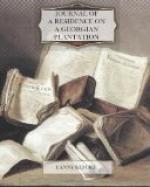from others, but as I am aware of the risk which I
run in so doing, I shall furnish you with no details
but those which come under my own immediate observation.
To return to the rice mill: it is worked by a
steam-engine of thirty horse power, and besides threshing
great part of our own rice, is kept constantly employed
by the neighbouring planters, who send their grain
to it in preference to the more distant mill at Savannah,
paying, of course, the same percentage, which makes
it a very profitable addition to the estate.
Immediately opposite to this building is a small shed,
which they call the cook’s shop, and where the
daily allowance of rice and corn grits of the people
is boiled and distributed to them by an old woman,
whose special business this is. There are four
settlements or villages (or, as the negroes call them,
camps) on the island, consisting of from ten to twenty
houses, and to each settlement is annexed a cook’s
shop with capacious cauldrons, and the oldest wife
of the settlement for officiating priestess.
Pursuing my walk along the river’s bank, upon
an artificial dyke, sufficiently high and broad to
protect the fields from inundation by the ordinary
rising of the tide—for the whole island
is below high water mark—I passed the blacksmith’s
and cooper’s shops. At the first all the
common iron implements of husbandry or household use
for the estate are made, and at the latter all the
rice barrels necessary for the crop, besides tubs
and buckets large and small for the use of the people,
and cedar tubs of noble dimensions and exceedingly
neat workmanship, for our own household purposes.
The fragrance of these when they are first made, as
well as their ample size, renders them preferable
as dressing-room furniture, in my opinion, to all
the china foot-tubs that ever came out of Staffordshire.
After this I got out of the vicinity of the settlement,
and pursued my way along a narrow dyke—the
river on one hand, and on the other a slimy, poisonous-looking
swamp, all rattling with sedges of enormous height,
in which one might lose one’s way as effectually
as in a forest of oaks. Beyond this, the low
rice-fields, all clothed in their rugged stubble, divided
by dykes into monotonous squares, a species of prospect
by no means beautiful to the mere lover of the picturesque.
The only thing that I met with to attract my attention
was a most beautiful species of ivy, the leaf longer
and more graceful than that of the common English
creeper, glittering with the highest varnish, delicately
veined, and of a rich brown green, growing in profuse
garlands from branch to branch of some stunted evergreen
bushes which border the dyke, and which the people
call salt-water bush. My walks are rather circumscribed,
inasmuch as the dykes are the only promenades.
On all sides of these lie either the marshy rice-fields,
the brimming river, or the swampy patches of yet unreclaimed
forest, where the huge cypress trees and exquisite
evergreen undergrowth spring up from a stagnant sweltering
pool, that effectually forbids the foot of the explorer.




